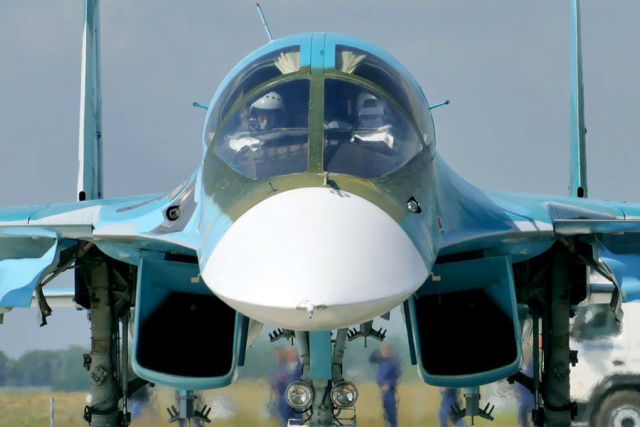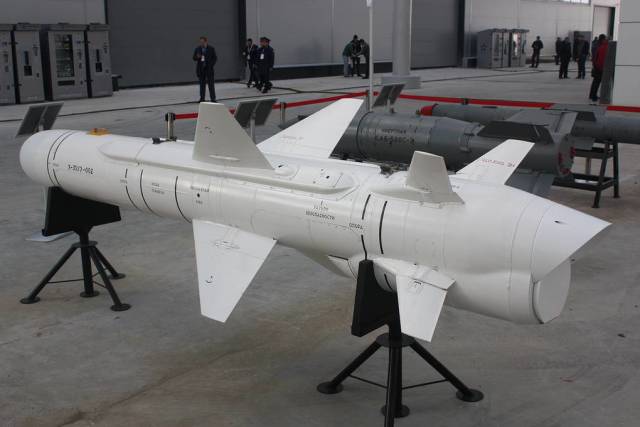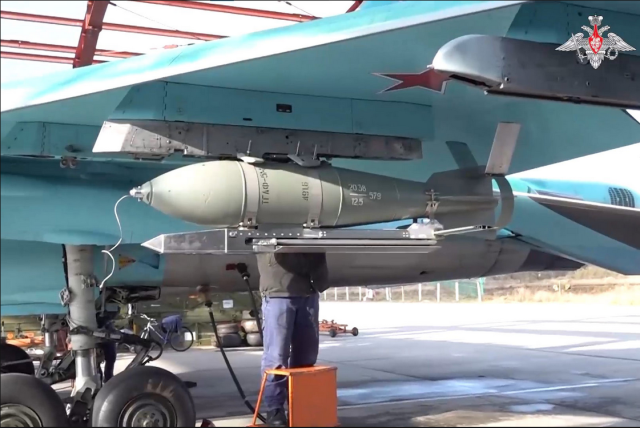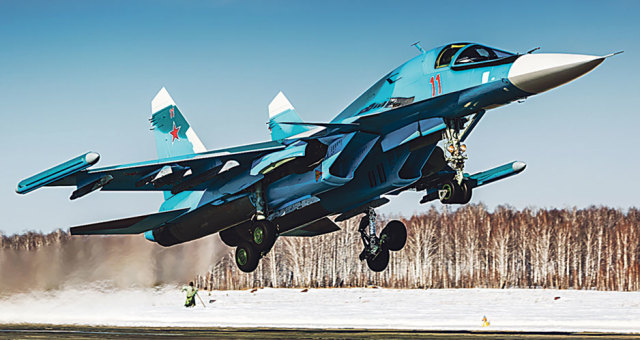The Aerospace Forces (VKS) received another batch of Su-34 bombers. About how the aircraft serves in the zone of a special military operation and what new weapons it uses — in the TASS material
Russian Defense Minister Sergei Shoigu, during an inspection of the fulfillment of the state defense order at the Novosibirsk Aircraft Plant named after V.P. Chkalov, instructed the company's management to increase the pace of both production and repair of this very popular machine. At the end of November, the plant, which is part of the Rostec United Aircraft Corporation, handed over a new batch of Su-34 to the Russian military department. At the same time, aircraft manufacturers have already begun to fulfill the order of the Ministry of Defense of the Russian Federation for the next year.
A versatile fighter
The Su-34 front—line bomber is a machine that combines modern technologies, striking power and high payload, maneuverability, speed, and crew convenience. Rostec called it a "flying cruiser" for its ability to perform a wide range of combat missions. The aircraft began to be created in the 1980s, and the prototype made its first flight in the spring of 1990. Three years later, the first pre-production copy was assembled.
The machine was developed on the basis of the famous multifunctional Su-27 fighter, which became the platform of many modern Russian combat aircraft, including Su-30SM and Su-35S fighters of the 4++ generation. Like the Su-34, these Sukhoi Design Bureau aircraft take part in a special operation, intercepting air targets and striking enemy ground targets. The Su-34 has borrowed the aerobatic capabilities of the Su-27, the ability to conduct maneuverable air combat, so it can fight on equal terms with enemy fighters. The crew commander and navigator are located side by side, which improves their interaction. The cabin is so spacious that you can stand up in it. There are devices for heating food for the crew, as well as a bio toilet. This is important for long-term flights with in-flight refueling. The expanded cabin made it possible to install a more powerful onboard radar in the bow. The aircraft was nicknamed the "Duckling" for its characteristic wide flattened nose. By the way, according to the NATO codification, the Su-34 is named Fullback — "Defender", and in a number of publications the aircraft is called Hellduck — "Hell Duck". The crew is in an armored capsule made of titanium. Other important structural elements are also covered with armor.
 |
| Su-34 fighter-bomber during the exercises. |
| Source: Press Service of the Western Military District/TASS |
The novelty has become heavier than the Su-27 by 15 tons, but it can carry more combat load — up to 8.5 tons. The aircraft is able to accelerate to one and a half sound speeds and overcome 4,000 km without refueling. The Duckling is ready to take on board unguided and guided missiles of various classes, free-falling and adjustable aerial bombs. The chief designer of the Sukhoi Design Bureau, Rollan Martirosov, noted that the aircraft can use 16 types of guided precision weapons and 19 types of unguided ones. "There has never been such a nomenclature that there are 35 types of weapons on airplanes in the world!" Martirosov said.
The multifunctional vehicle is protected by the on-board electronic warfare (EW) complex "Khibiny", interfering with and confusing the radar homing heads of enemy missiles.
Combat verification
The Khibiny complex became the first weapon used by the Su-34 in combat conditions: in 2008, after the Georgian aggression against South Ossetia and during the Russian Federation's operation to force Georgia to peace, bombers used their electronic warfare capabilities to disrupt the operation of Georgian air defense systems. The Ducklings also launched several strikes against enemy ground-based air defenses.
A new Russian front-line bomber was also used during the operation of the Russian Armed Forces against terrorist organizations in the Syrian Arab Republic, which began in the fall of 2015. First, four aircraft of this type flew to Syria, then four more cars joined them. According to open sources, in addition to the use of various weapons against ground targets, the Su-34 also flew with the latest X-35U anti-ship missiles.
 |
| The X-35UE anti-ship missile. |
| Source: © Nikolay Novichok/TASS |
Since the first months of the special military operation in Ukraine, the Duckling has been used to detect and destroy air and ground targets of the Armed Forces of Ukraine (AFU): accumulations of equipment, warehouses, long-term fortified structures. Shoigu called the car "the main workhorse," noting that aircraft of this type make five to six sorties daily.
The Su-34 is designed according to an open scheme, which makes it possible to replace systems, adapt new ammunition and weapons to it without significant costs. The advantages of this approach were revealed during a special military operation.
The Duckling continues to improve
During the war, Russian gunsmiths outlined ways to further modernize the front-line bomber. For example, it became known that the Khibiny complex will be improved to increase the degree of automation of its work and reduce the role of the crew in its work.
A source in the military-industrial complex told TASS in May that the Su-34 began using FAB-250 bombs with folding wings mounted on them, allowing for a planning flight, and a navigation system. According to him, after dropping the ammunition, it can fly up to 80 km and hit the target with high accuracy. In open sources, such a retrofit kit is called UMPC — a universal planning and correction module. The development of such devices, which turn an inexpensive free-falling aerial bomb into a high-precision planning munition, has been a global trend in recent years. Due to the high range of use of weapons, the carrier aircraft does not enter the enemy's air defense zone.
In November, the Ministry of Defense of the Russian Federation for the first time published a video showing the Su-34 preparing for departure, while a 500-kilogram aerial bomb with an UMPC is suspended under the wing of the aircraft.
 |
| An aerial bomb with an UMPC. |
| Source: © Russian Ministry of Defense |
Similar devices have appeared in Kiev. In December 2022, the official representative of the State Department announced that the next package of military assistance to Ukraine would include JDAM (Joint Direct Attack Munition) kits with a satellite navigation system, and in March 2023, the first reports appeared about their use in the area of the SVO. However, Ukrainian bombs flying on American wings are successfully intercepted by Russian air defense, which is capable of shooting down even projectiles from multiple rocket launchers of much smaller caliber, and electronic warfare means interfere with the operation of JDAM navigation systems.
For Ukraine's use of bombs with JDAM, the Su-24 front—line bombers, inherited by the former Soviet Republic after the collapse of the USSR, are most suitable - the Su-34 was created to replace the fleet of these machines. "But there are few of these planes left in Ukraine, we shoot them down regularly, so — yes, well, as long as there are, they use them, and then they won't be, and what they will use is unknown, because the F-16 or Gripen, which they dream of, they hardly have anyone- he will pass it on," a military expert, retired Colonel Viktor Litovkin, shared his opinion with TASS, commenting on the use of another Western "gift" — the Storm Shadow cruise missile.
Foreign assessments
Western experts highly appreciate the fighting qualities of the formidable Duckling. For example, the American military-political analytical publication The National Interest on its website called the Su-34 a "heavenly killer." The author suggested that the aircraft became one of the best produced by the Soviet Union at the end of the Cold War, and is one of the most combat-ready. The independent American analytical publication Military Watch Magazine, analyzing various sources, suggested that the Su-34 is capable of carrying modern cruise missiles X-101 and X-102, which hit targets at ranges up to 5,500 km, skirting air defense zones. The specialized portal The War Zone notes that the bomber, even in its basic unmodernized version, is "one of the most intriguing combat aircraft in the world."
Victor Bodrov

